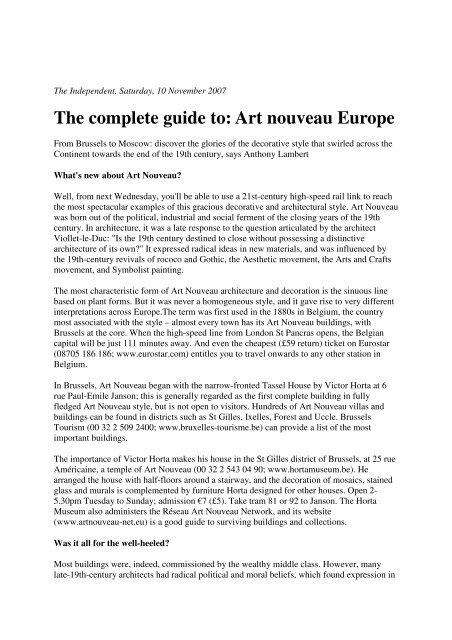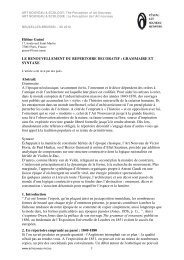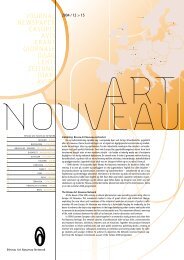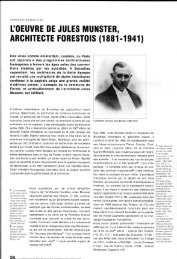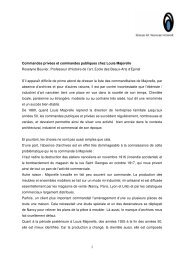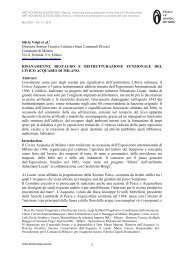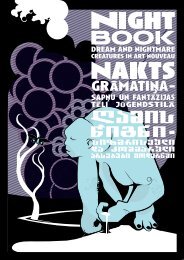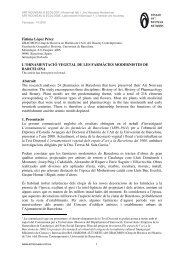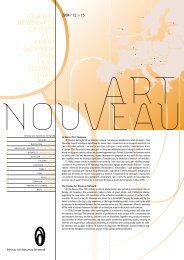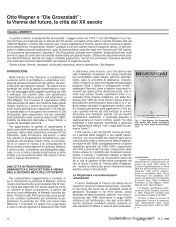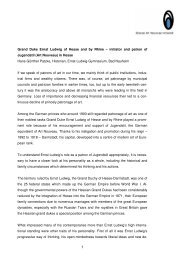The complete guide to: Art nouveau Europe - Art Nouveau Network
The complete guide to: Art nouveau Europe - Art Nouveau Network
The complete guide to: Art nouveau Europe - Art Nouveau Network
Create successful ePaper yourself
Turn your PDF publications into a flip-book with our unique Google optimized e-Paper software.
<strong>The</strong> Independent, Saturday, 10 November 2007<br />
<strong>The</strong> <strong>complete</strong> <strong>guide</strong> <strong>to</strong>: <strong>Art</strong> <strong>nouveau</strong> <strong>Europe</strong><br />
From Brussels <strong>to</strong> Moscow: discover the glories of the decorative style that swirled across the<br />
Continent <strong>to</strong>wards the end of the 19th century, says Anthony Lambert<br />
What's new about <strong>Art</strong> <strong>Nouveau</strong>?<br />
Well, from next Wednesday, you'll be able <strong>to</strong> use a 21st-century high-speed rail link <strong>to</strong> reach<br />
the most spectacular examples of this gracious decorative and architectural style. <strong>Art</strong> <strong>Nouveau</strong><br />
was born out of the political, industrial and social ferment of the closing years of the 19th<br />
century. In architecture, it was a late response <strong>to</strong> the question articulated by the architect<br />
Viollet-le-Duc: "Is the 19th century destined <strong>to</strong> close without possessing a distinctive<br />
architecture of its own?" It expressed radical ideas in new materials, and was influenced by<br />
the 19th-century revivals of rococo and Gothic, the Aesthetic movement, the <strong>Art</strong>s and Crafts<br />
movement, and Symbolist painting.<br />
<strong>The</strong> most characteristic form of <strong>Art</strong> <strong>Nouveau</strong> architecture and decoration is the sinuous line<br />
based on plant forms. But it was never a homogeneous style, and it gave rise <strong>to</strong> very different<br />
interpretations across <strong>Europe</strong>.<strong>The</strong> term was first used in the 1880s in Belgium, the country<br />
most associated with the style – almost every <strong>to</strong>wn has its <strong>Art</strong> <strong>Nouveau</strong> buildings, with<br />
Brussels at the core. When the high-speed line from London St Pancras opens, the Belgian<br />
capital will be just 111 minutes away. And even the cheapest (£59 return) ticket on Eurostar<br />
(08705 186 186; www.eurostar.com) entitles you <strong>to</strong> travel onwards <strong>to</strong> any other station in<br />
Belgium.<br />
In Brussels, <strong>Art</strong> <strong>Nouveau</strong> began with the narrow-fronted Tassel House by Vic<strong>to</strong>r Horta at 6<br />
rue Paul-Emile Janson; this is generally regarded as the first <strong>complete</strong> building in fully<br />
fledged <strong>Art</strong> <strong>Nouveau</strong> style, but is not open <strong>to</strong> visi<strong>to</strong>rs. Hundreds of <strong>Art</strong> <strong>Nouveau</strong> villas and<br />
buildings can be found in districts such as St Gilles, Ixelles, Forest and Uccle. Brussels<br />
Tourism (00 32 2 509 2400; www.bruxelles-<strong>to</strong>urisme.be) can provide a list of the most<br />
important buildings.<br />
<strong>The</strong> importance of Vic<strong>to</strong>r Horta makes his house in the St Gilles district of Brussels, at 25 rue<br />
Américaine, a temple of <strong>Art</strong> <strong>Nouveau</strong> (00 32 2 543 04 90; www.hortamuseum.be). He<br />
arranged the house with half-floors around a stairway, and the decoration of mosaics, stained<br />
glass and murals is complemented by furniture Horta designed for other houses. Open 2-<br />
5.30pm Tuesday <strong>to</strong> Sunday; admission €7 (£5). Take tram 81 or 92 <strong>to</strong> Janson. <strong>The</strong> Horta<br />
Museum also administers the Réseau <strong>Art</strong> <strong>Nouveau</strong> <strong>Network</strong>, and its website<br />
(www.art<strong>nouveau</strong>-net.eu) is a good <strong>guide</strong> <strong>to</strong> surviving buildings and collections.<br />
Was it all for the well-heeled?<br />
Most buildings were, indeed, commissioned by the wealthy middle class. However, many<br />
late-19th-century architects had radical political and moral beliefs, which found expression in
social housing projects such as rue Blaes in Brussels and Mechelsestraat in Lier, 15 minutes<br />
by train from Antwerp Central. <strong>The</strong> high-minded object was <strong>to</strong> create homes that workers<br />
would regard as worth coming home <strong>to</strong>, rather than head for a bar.<br />
<strong>Art</strong> <strong>Nouveau</strong> had less impact on commercial buildings, but some outstanding examples<br />
survive. Most spectacular is the Musical Instrument Museum (00 32 2 545 0130;<br />
www.mim.fgov.be) at 2 rue Montagne de la Cour in Brussels, originally designed in 1899 by<br />
Paul Saintenoy <strong>to</strong> be the Old England department s<strong>to</strong>re. Walk uphill from the Gare Centrale<br />
area, or take tram 92, 93 or 94 <strong>to</strong> Royale.<br />
In Austria, one of the leading <strong>Art</strong> <strong>Nouveau</strong> buildings is the exhibition space commissioned by<br />
the Vienna Secession for its members' work (00 43 1 5875 30721; www.secession.at).<br />
Located at 12 Friedrichstrasse, Joseph Olbrich's resolutely geometric façade is crowned by a<br />
stunning gilded leaf-covered cupola that contemporaries unkindly christened "the golden<br />
cabbage" when the Secession Building opened in 1898. Open 10am-6pm daily except<br />
Monday; admission €1.50-€6 (£1-£4.30).<br />
Where else?<br />
<strong>Art</strong> <strong>Nouveau</strong> design was given a tremendous boost by the 1900 Paris Universal Exposition,<br />
which covered 112 hectares and was visited by over 50 million people. A surviving relic can<br />
be found in the churchyard of St-Germain-des- Prés: the <strong>Art</strong> <strong>Nouveau</strong> s<strong>to</strong>neware façade of the<br />
Sèvres pavilion was moved there. It was also in Paris that the name <strong>Art</strong> <strong>Nouveau</strong> was<br />
institutionalised with the opening in 1895 of a gallery named La Maison d'<strong>Art</strong> <strong>Nouveau</strong>. It<br />
had a greater influence than its short life of only nine years would suggest, selling as many<br />
pieces <strong>to</strong> forward-thinking museums as individuals.<br />
<strong>Art</strong> <strong>Nouveau</strong> was not as pervasive in France as in Belgium, but the <strong>Art</strong> <strong>Nouveau</strong> design with<br />
which people are most familiar is that of the distinctive Parisian Métro entrances created by<br />
Hec<strong>to</strong>r Guimard. Designed <strong>to</strong> enhance the experience of a journey on the French capital's new<br />
underground railway, the cast-iron and glass entrances were a modular system whose<br />
components could form five different styles depending on the station's size, location and<br />
importance. <strong>The</strong>y graced the entrances <strong>to</strong> stations on the Métro lines built <strong>to</strong> cope with the<br />
1900 Exposition. Many have disappeared, but good examples remain at Porte Dauphine,<br />
Louvre, Abbesses and Cité, among others.<br />
Parisian masterpieces?<br />
Paris was the centre of French <strong>Art</strong> <strong>Nouveau</strong> design, and one of Guimard's masterpieces can be<br />
found at 14 rue La Fontaine, the Castel Béranger. Constructed from 1895-7, it was his first<br />
building in the style. He mounted an exhibition <strong>to</strong> publicise the building and its 36 apartments<br />
in the fashionable suburb of Auteuil, where there were 300 other <strong>Art</strong> <strong>Nouveau</strong>-inspired<br />
houses by 1910, many of which survive. Furniture designed by Guimard for Castel Béranger<br />
can be seen in the Musée d'Orsay (00 33 1 40 49 48 14; www.musee-orsay.fr), at 1 rue de la<br />
Légion d'Honneur (Métro Assemblée Nationale). Open 9.30am-6pm Tuesday <strong>to</strong> Sunday;<br />
admission €7.50/£5.30).<br />
Probably the most bizarre <strong>Art</strong> <strong>Nouveau</strong> doorway in Paris belongs <strong>to</strong> the apartment building at<br />
29 avenue Rapp (Métro Ecole Militaire) designed by Jules Lavirotte; the sexual imagery
includes male genitalia on the front door and upper windows and balcony, supported by a<br />
form resembling female genitalia. It won Lavirotte an international design prize in 1901.<br />
Beyond Paris?<br />
A more literal translation of natural forms characterised the work of some of the artists and<br />
craftsmen who formed the Nancy School around the celebrated ceramicist Emile Gallé, whose<br />
stunning glasswork can be seen at <strong>The</strong> School of Nancy Museum at 36-38 rue du Sergent<br />
Blandan (00 33 3 83 40 14 86; www.ot-nancy.fr/uk/musees). It's open 10.30am-6pm<br />
Wednesday <strong>to</strong> Sunday; admission €6 (£4.30). It has displays of <strong>Art</strong> <strong>Nouveau</strong> furniture, objets<br />
d'art, glassware, stained glass, leather, ceramics and textiles. <strong>The</strong> principal architectural<br />
achievement of the Nancy School was the u o Villa Majorelle (00 33 3 83 40 14 86;<br />
www.ecole-de-nancy.com) designed largely by Henri Sauvage. It is a gracious mansion in<br />
pleasant grounds outside the city centre; <strong>guide</strong>d <strong>to</strong>urs of the house are organised by the<br />
museum on Saturdays and Sundays from May <strong>to</strong> Oc<strong>to</strong>ber, and on Saturdays only from<br />
November <strong>to</strong> April, at 2.30 and 3.45pm; booking is advisable.<br />
Further east?<br />
In Germany, <strong>Art</strong> <strong>Nouveau</strong> was adopted as Jugendstil, and became a hallmark of progressive<br />
taste. An excellent example is Darmstadt, 20 minutes south of Frankfurt by frequent trains.<br />
Grand Duke Ernst Ludwig founded, in 1899, an atelier of Jugendstil craftsmen who lived in a<br />
surrounding colony of houses in the same style. This unique cluster of Jugendstil houses<br />
includes the first house designed by Peter Behrens (in whose Berlin office Walter Gropius,<br />
Mies van der Rohe and Le Corbusier were all working in 1910). <strong>The</strong> atelier building, the<br />
Mathildenhöhe at 26 Alexandraweg, has been res<strong>to</strong>red and is now a museum (00 49 6151<br />
133385; www.darmstadt.), open 10am-5pm daily except Monday. Admission €5 (£3.50).<br />
Between Trier and Koblenz is the <strong>to</strong>wn of Traben-Trarbach, once the second-largest winetrading<br />
centre in the world, where a bridge spanning the Mosel is guarded by a twin-<strong>to</strong>wered<br />
Jugendstil gateway, <strong>complete</strong>d in 1899. <strong>The</strong> <strong>to</strong>wn itself has many fine Jugendstil villas<br />
commissioned by wealthy wine merchants. <strong>The</strong> romantic Jugendstil Hotel Bellevue (00 49<br />
6541 7030;www.bellevue-hotel.de), at Am Moselufer, was designed by Bruno Moehring in<br />
1903; it has elaborate timberwork, an intricate <strong>to</strong>wer and antiques in many rooms. Doubles<br />
from €130 (£93) including breakfast. Traben-Trarbach is easily accessible from Hahn airport<br />
on Ryanair (0871 246 0000; www.ryanair.com), which calls it "Frankfurt".<br />
<strong>Europe</strong>an expansion?<br />
<strong>Art</strong> <strong>Nouveau</strong> soon influenced architects right across the Continent, from Portugal <strong>to</strong> Russia,<br />
though it was a short-lived style, and had already become unfashionable by the outbreak of<br />
the First World War. Logically enough, its influence was often greatest in places experiencing<br />
a housing boom, sometimes in tragic circumstances. In 1904, the Norwegian coastal <strong>to</strong>wn of<br />
Aalesund was almost <strong>complete</strong>ly destroyed by fire. <strong>The</strong> young Norwegian architects<br />
rebuilding the <strong>to</strong>wn over the next three years independently fused <strong>Art</strong> <strong>Nouveau</strong> with national<br />
romantic symbols such as dragons' heads, giving the harbour <strong>to</strong>wn a rare unified character. In<br />
the one-time pharmacy and house of a chemist, at 16 Apotekergata, the <strong>Art</strong> <strong>Nouveau</strong> Centre<br />
(00 47 70 10 49 70) has preserved rooms and holds exhibitions, with an imaginative<br />
multimedia time-machine (in English) about the <strong>to</strong>wn's reconstruction. Open 11am-4pm<br />
Tuesday <strong>to</strong> Saturday, noon-4pm on Sunday; admission Nkr50 (£4.50).
Right in the centre of Aalesund, at 8 Lovenvoldgata, is Rica Hotel Scandinavie (00 47<br />
70157800; www.rica-hotels.com), which retains <strong>Art</strong> <strong>Nouveau</strong> decoration in some of the<br />
public rooms as well as unaltered façades. Doubles from Nkr990 (£88) including breakfast.<br />
SAS flies <strong>to</strong> Aalesund twice weekly from Gatwick (0870 60 727 727; www.flysas.co.uk),<br />
from £112 return.<br />
At the end of the 19th century, Riga was growing so rapidly that its population doubled in 15<br />
years. Again, the vogue for <strong>Art</strong> <strong>Nouveau</strong> buildings was fuelled by an international exhibition<br />
in the Latvian capital in 1901, where many of the pavilions were built in the style, which was<br />
also adopted for over a third of the buildings in the city centre. <strong>The</strong> <strong>Art</strong> <strong>Nouveau</strong> doorways of<br />
Riga alone could fill a book.<br />
In Moscow, the Gorky Museum occupies the Ryabushinsky House, built from 1900-3 <strong>to</strong> a<br />
design by Fyodor Shekhtel, at 6/2 Ulitsa Malaya Nikitskaya (00 7 495 290 0535), with a<br />
twisting marble staircase lit by stained glass. <strong>The</strong> writer Maxim Gorky lived in the house from<br />
1931 <strong>to</strong> 1936, despite disliking <strong>Art</strong> <strong>Nouveau</strong>. It's open noon-7pm Wednesday and Friday, and<br />
10am-5pm Thursday, Saturday and Sunday, closed last Friday of the month.Metro<br />
Arbatskaya.<br />
Interest in <strong>Art</strong> <strong>Nouveau</strong> underwent a revival in the Seventies when reproductions of posters of<br />
Sarah Bernhardt by the Czech designer Alphonse Mucha became popular. <strong>The</strong> finest<br />
collection of his original work is in the Mucha Museum at 7 Panska, Prague (00 420 221 451<br />
333; www.mucha.cz), situated in the baroque Kaunicky Palace. Open 10am-6pm daily;<br />
admission Czk120 (£3). Metro Muzeum or Mustek.<br />
Further south?<br />
In Italy, <strong>Art</strong> <strong>Nouveau</strong> was named Stile Liberty in recognition of the influence of the London<br />
s<strong>to</strong>re. <strong>The</strong> principal centre is Milan, where there are several hundred buildings in the style.<br />
<strong>The</strong> places used as weekend retreats by wealthy Milanese – such as Stresa, Bellagio and<br />
Verbania – also feature some <strong>Art</strong> <strong>Nouveau</strong> villas. In Milan, peacocks decorate part of the <strong>Art</strong><br />
<strong>Nouveau</strong> block of 16-22 Via Pisacane, and the Galimberti house on Via Malpighi was<br />
covered in ceramic cladding by Giovan Bossi <strong>to</strong> introduce Liberty themes (as well as making<br />
the building easier <strong>to</strong> clean).<br />
One of the largest museum collections of <strong>Art</strong> <strong>Nouveau</strong> is in Lisbon, though the city has few<br />
buildings in the style. <strong>The</strong> Calouste Gulbenkian Museum (00 351 21 782 3000; www.<br />
museu.gulbenkian.pt) was endowed by the Armenian oil magnate and collec<strong>to</strong>r, and has an<br />
extensive collection of Lalique glass and jewellery. At 45A avenida de Berna (metro Sao<br />
Sebastiao or Praca de Espanha), it's open 10am-5.45pm daily except Monday; admission €4<br />
(£2.80).<br />
Anything closer <strong>to</strong> home?<br />
No and yes. Although the <strong>Art</strong>s and Crafts Movement was a seminal source of inspiration <strong>to</strong><br />
<strong>Art</strong> <strong>Nouveau</strong> designers, architects in Britain never <strong>to</strong>ok the style <strong>to</strong> heart. But the concept that<br />
even functional objects should be beautiful and expressive was derived from the <strong>Art</strong>s and<br />
Crafts Movement, and the writings of designers such as William Morris. <strong>The</strong> best introduction<br />
<strong>to</strong> the design philosophy is perhaps Blackwell at Bowness-on-Windermere, off the B5360<br />
(015394 46139; www.blackwell.org.uk). Open 10.30am-4pm daily; admission £5.45. This
magnificent holiday home, created in 1900 for the brewer Sir Edward Holt by M H Baillie<br />
Scott, is exceptional for the survival of so much of its interior decoration.<br />
One of the finest English collections of <strong>Art</strong>s and Crafts items is at Cheltenham <strong>Art</strong> Gallery &<br />
Museum in Clarence Street (01242 237431), which is so extensive that it incorporates an <strong>Art</strong>s<br />
and Crafts Museum (www.artsandcraftsmuseum.org.uk), reflecting the importance of artists<br />
working in the Cotswolds at the time. <strong>The</strong> collection includes furniture, pottery, silver,<br />
metalwork, jewellery, plasterwork, leatherwork, private-press books, textiles and<br />
embroideries. Open 10am-5.20pm daily except Sunday; admission free.<br />
Brigh<strong>to</strong>n Museum & <strong>Art</strong> Gallery, in Church Street, 15 minutes' walk from the station (01273<br />
292882; www.virtual museum.info) has the best British public collection, outside of the<br />
Vic<strong>to</strong>ria and Albert Museum, of French <strong>Art</strong> <strong>Nouveau</strong> and Austrian Secession design; it<br />
includes furniture by Majorelle, Rennie Mackin<strong>to</strong>sh, Hoffmann and Moser, and furniture,<br />
ceramics and glass by Gallé. Open 10am-5pm Tuesday <strong>to</strong> Saturday, until 7pm on Tuesday<br />
and 2-5pm on Sunday; admission free.<br />
Dining out with art <strong>nouveau</strong><br />
Predictably, some of the best <strong>Art</strong> <strong>Nouveau</strong> restaurants are in Paris. Foremost is Maxim's (00<br />
33 142 65 27 94; www.maxims-de-paris.com) at 3 rue Royale; Métro Concorde. It was<br />
designed by Louis Marnez from 1898–1900 using School of Nancy artists. Pierre Cardin, who<br />
has owned the restaurant since 1981, has collected over 550 pieces of <strong>Art</strong> <strong>Nouveau</strong>, some of<br />
which are on display in the Maxim's museum (open 2-5.30pm Wednesday <strong>to</strong> Sunday, with<br />
<strong>to</strong>urs by art his<strong>to</strong>rians at 2pm, 3.15pm and 4.30pm; admission €€15/£11). Lunch and a<br />
museum visit Tuesday-Friday costs €€110 (£79). <strong>The</strong> restaurant is closed for Saturday lunch,<br />
and on Sunday and Monday.<br />
<strong>The</strong> interior of Lucas Car<strong>to</strong>n (now called Senderens), at 9 place de la Madeleine (Métro<br />
Madeleine), was designed by Majorelle (00 33 1 42 65 22 90; www.lucascar<strong>to</strong>n.com). Open<br />
noon-3pm, 7.30-11.15pm daily. And Bouillon Racine (00 33 1 44 32 15 60; www.bouillonracine.com)<br />
at 3 rue Racine (Métro Cluny-La Sorbonne), now a listed national monument,<br />
was created in 1906 and retains its <strong>Art</strong> <strong>Nouveau</strong> features. Open noon-11pm every day.<br />
Metro massacre<br />
<strong>Art</strong> <strong>Nouveau</strong> did not remain popular for long in Paris: Le Figaro even campaigned <strong>to</strong> get<br />
Guimard's Métro entrances removed, and as late as 1962, some of them were still being<br />
demolished. <strong>The</strong> French capital's first wake-up call was when the New York Museum of<br />
Modern <strong>Art</strong> bought one of the jettisoned entrances. It is still on display at MoMA, at 11 West<br />
53rd Street (001 212 708 9400; www.moma.org), which is open 10.30am-5.30pm Wednesday<br />
<strong>to</strong> Monday, with late opening <strong>to</strong> 8pm on Friday; admission $20 (£10).<br />
Even after the Second World War, French museums refused the offer by Guimard's widow of<br />
his collection, so she gave it MoMA and <strong>to</strong> the Metropolitan Museum of <strong>Art</strong> (001 212 535<br />
7710; www.metmuseum.org).<br />
<strong>The</strong> Met, at 1000 Fifth Avenue on 82nd Street, is open 9.30am-5.30pm daily except Monday,<br />
with late opening <strong>to</strong> 9pm on Friday and Saturday; admission $20 (£10). On 4 December, the<br />
second-floor 19th-century Paintings and Sculptures galleries reopen after renovation and
additions, notably the reassembly of the <strong>Art</strong> <strong>Nouveau</strong> "Wisteria Dining Room" created by the<br />
French artist Lucien Lévy-Dhurmer. Lectures on <strong>Art</strong> <strong>Nouveau</strong> in Brussels and Paris, and in<br />
Eastern <strong>Europe</strong> are being given on 27 November and 18 December respectively; tickets $23<br />
(£11.50).


